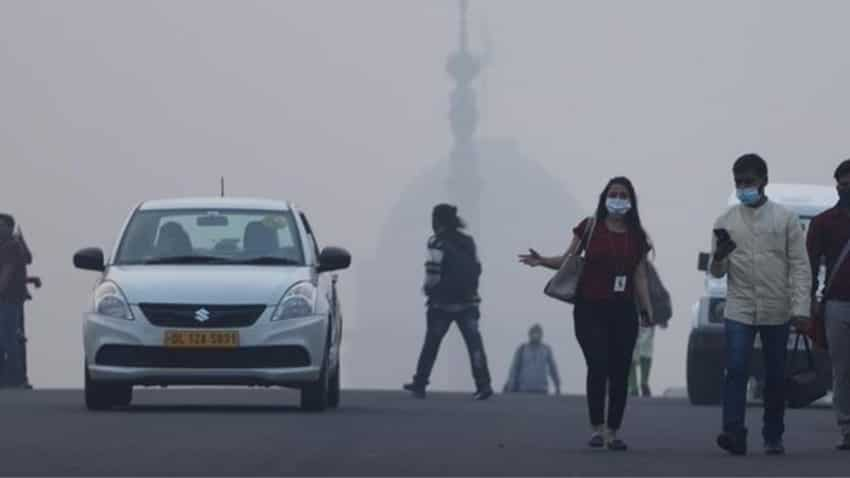Delhi's air quality deteriorates to 'poor' with index crosses 300: CPCB data
The national capital’s air quality on Saturday touched the ‘poor’ category mark with its Air Quality Index crossing 300, data from the Central Pollution Control Board (CPCB) revealed.

The national capital’s air quality on Saturday touched the ‘poor’ category mark with its Air Quality Index crossing 300, data from the Central Pollution Control Board (CPCB) revealed.
However, the city’s air quality which usually starts deteriorating at this time to year may take a little longer before it starts dipping to the ‘very poor’ to ‘severe’ category, according to the Indian Meteorological Department (IMD).
See Zee Business Live TV Streaming Below:
"For October 17 and 18, we have prediction of rain," V.K. Soni, Head of Environment and Research Centre at the IMD, told IANS.
"This year the monsoon was late by 10 days and we had a very good rain in the month of September. So, we had better air quality. Till October 4, we had 33 Air Quality Index after that it started deteriorating. Till yesterday (Friday), it was in `moderate` category and now it is in the `poor` category but the winds will change and we are expecting that the air quality will improve from tonight onwards.
"Till October 18, it will remain in ‘moderate’ category and then again we are expecting that it will deteriorate to ‘poor’ again," he told IANS.
With the onset of winter and the withdrawal of monsoon in the northwest region of the country, the wind changes direction from easterly to north-westerly. Along with that, as the temperature dips the pollutants are unable to disperse in the upper layer of atmosphere as freely and widely as it does during summer season, leading to high concentration of pollutants in the air.
In addition to the above, Delhi-NCR’s own dust and vehicular pollution; stubble burning in the neighbouring states of Punjab, Uttar Pradesh, Rajasthan and Haryana; storms carrying dust arrive from Rajasthan and countries such as Pakistan and Afghanistan lead to the high level of toxic pollution in the capital city.
Doctors have said that that worsening air quality and rising level of pollutants in the air lead to an increase in the number and severity of respiratory illness and disorders.
The most vulnerable of all are the elderly and young population.
A research conducted by The Energy and Research Institute (TERI) on over 400 children had found that 75.4 per cent of them complained of breathlessness, 24.2 per cent of itchy eyes, 75.4 per cent regular sneezing or runny nose and 20.9 per cent of having coughs in the morning.
Get Latest Business News, Stock Market Updates and Videos; Check your tax outgo through Income Tax Calculator and save money through our Personal Finance coverage. Check Business Breaking News Live on Zee Business Twitter and Facebook. Subscribe on YouTube.
RECOMMENDED STORIES

SIP Stock Pick For New Year 2025: Anil Singhvi recommends buying this largecap pharma stock on 10% dip

Top 7 Index Mutual Funds With Best SIP Returns in 10 Years: Rs 11,111 monthly SIP investment in No. 1 fund is now worth Rs 33,18,831; know how others have fared

Largecap PSU Stock for 65% Gain in New Year: Anil Singhvi picks PSU bank for long term; know reasons and target prices

PPF vs SIP: Rs 12,000 monthly investment for 30 years; see which can create higher retirement corpus

Largecap Stocks To Buy: Analysts recommend buying Maruti Suzuki, 2 other stocks for 2 weeks; check targets

Power of Rs 15,000 SIP: How long it will take to achieve Rs 7 crore corpus? See calculations to know
04:59 PM IST








 Delhi schools shut: Primary schools in capital closed for 2 days due to severe pollution levels — AQI levels breached 400-mark in these areas
Delhi schools shut: Primary schools in capital closed for 2 days due to severe pollution levels — AQI levels breached 400-mark in these areas Diwali 2022: Firecrackers banned in Delhi; restrictions in other states | check guidelines in your city
Diwali 2022: Firecrackers banned in Delhi; restrictions in other states | check guidelines in your city  Delhi weather forecast today: Will rain play spoilsport on Diwali, Laxmi Puja?
Delhi weather forecast today: Will rain play spoilsport on Diwali, Laxmi Puja?